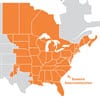Eastern Interconnection planning authorities analyzed interregional impacts and transfer capabilities for 2025 summer and winter peak hours
 ISO New England and other electric power system planning authorities are members of a collaborative that plans and conducts studies for the entire Eastern Interconnection. The Eastern Interconnection Planning Collaborative (EIPC) studies are used to support state, provincial, regional, and federal policy decision making. EIPC has recently published its latest analysis, the Report for 2025 Summer and Winter Roll-Up Integration Cases.
ISO New England and other electric power system planning authorities are members of a collaborative that plans and conducts studies for the entire Eastern Interconnection. The Eastern Interconnection Planning Collaborative (EIPC) studies are used to support state, provincial, regional, and federal policy decision making. EIPC has recently published its latest analysis, the Report for 2025 Summer and Winter Roll-Up Integration Cases.
What Are Roll-up Integration Cases?
One focus of the EIPC has been to analyze “roll-up” cases, which is a “bottom-up” approach that combines each member and participating entity’s electric power system plan into a comprehensive, updated model of the Eastern Interconnection. Although roll-up cases represent a “snapshot” of the ever-changing regional systems, they provide a sound basis for assessing the interregional impacts, transfer capabilities, and other interdependencies between and among the regions. The potential constraints and efficiencies identified through these analyses are valuable inputs into local and regional processes and, potentially, the individual regions’ transmission plans.
In 2015, the EIPC conducted two types of analysis to study roll-up integration cases for 2025 summer and winter peak hours. Twenty-four planning authorities provided input into the analysis and modeling of the cases, which were rigorously tested under reference (i.e., base case) and transfer conditions using North American Reliability Corporation (NERC) criteria.
Results of the interregional transmission “gap” analysis showed constraints for most planning authorities, with the highest overloads for the scenarios with multiple thermal contingencies. Most overloads, however, were caused by a local loading or resource issue amenable to local remedies. Future EIPC reliability analyses will monitor these issues to determine the need for local upgrades to transmission facilities.
Results of the linear transfer analysis showed that the future transmission system, as currently planned, can transfer more power between the regions than the long-term firm commitments modeled in the roll-up cases. The additional transfer capability ranged from 336 megawatts (MW) to over 5,000 MW.
About the EIPC
The EIPC was formed in 2009 under an agreement by Planning Authorities from 39 states in the eastern United States and in eastern Canada. EIPC membership presently includes Alcoa Power Generating, Inc.; Duke Energy Carolinas, LLC; Duke Energy Florida; Duke Energy Progress; Louisville Gas and Electric Company and Kentucky Utilities Company; Florida Power and Light Company; Georgia Transmission Corporation (An Electric Membership Corporation); ISO New England, Inc.; JEA; Midcontinent Independent Transmission System Operator, Inc.; Municipal Electric Authority of Georgia; New York Independent System Operator, Inc.; PJM Interconnection LLC; PowerSouth Energy Cooperative; South Carolina Electric and Gas Company; Southern Company Services Inc., as agent for Alabama Power Company, Georgia Power Company, Gulf Power Company, and Mississippi Power Company; Southwest Power Pool, Inc.; and the Tennessee Valley Authority.
- Categories
- Inside ISO New England
- Tags
- summer, transmission planning, winter
